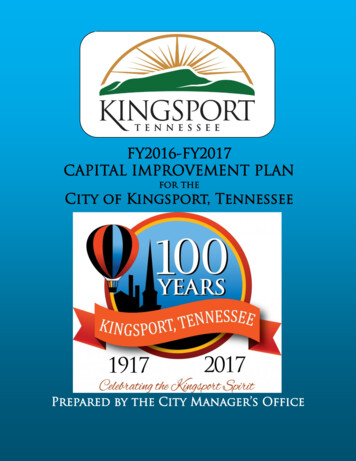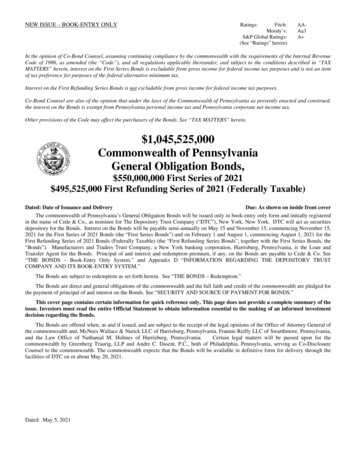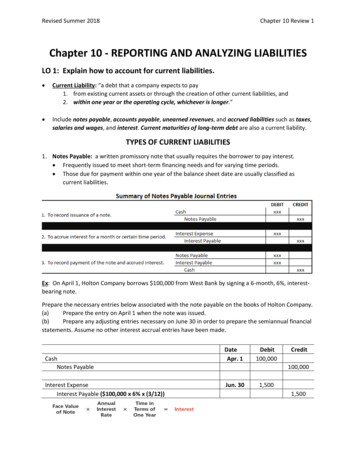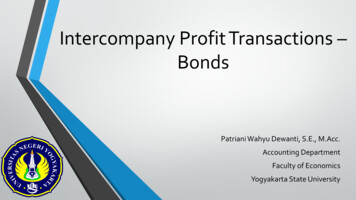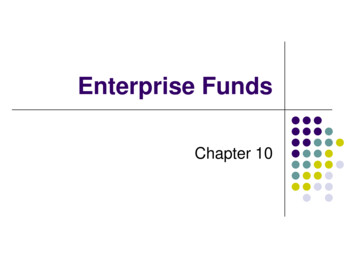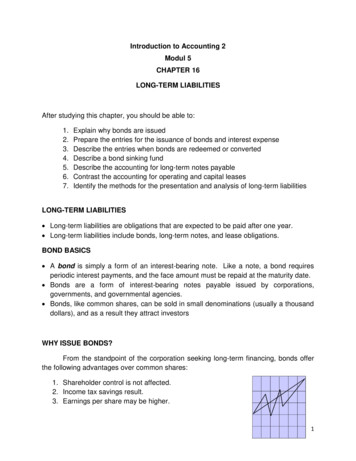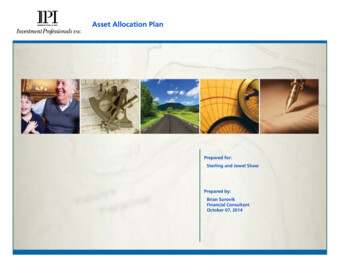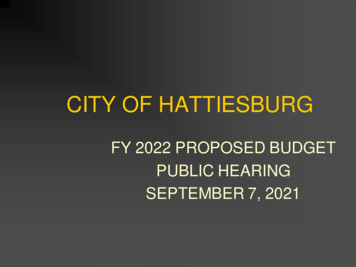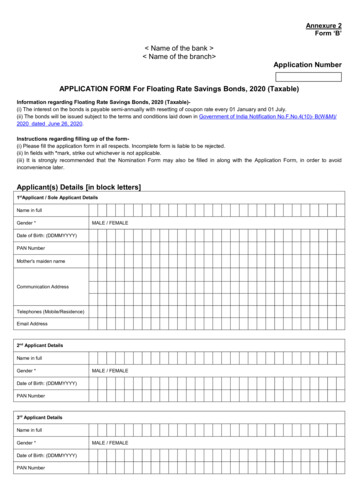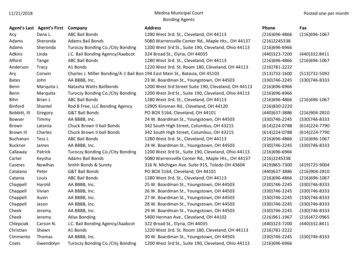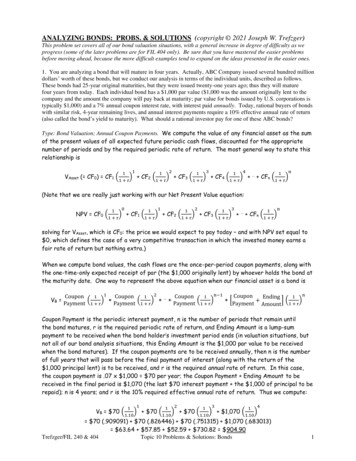
Transcription
ANALYZING BONDS: PROBS. & SOLUTIONS (copyright 2021 Joseph W. Trefzger)This problem set covers all of our bond valuation situations, with a general increase in degree of difficulty as weprogress (some of the later problems are for FIL 404 only). Be sure that you have mastered the easier problemsbefore moving ahead, because the more difficult examples tend to expand on the ideas presented in the easier ones.1. You are analyzing a bond that will mature in four years. Actually, ABC Company issued several hundred milliondollars’ worth of these bonds, but we conduct our analysis in terms of the individual units, described as follows.These bonds had 25-year original maturities, but they were issued twenty-one years ago; thus they will maturefour years from today. Each individual bond has a 1,000 par value ( 1,000 was the amount originally lent to thecompany and the amount the company will pay back at maturity; par value for bonds issued by U.S. corporations istypically 1,000) and a 7% annual coupon interest rate, with interest paid annually. Today, rational buyers of bondswith similar risk, 4-year remaining lives, and annual interest payments require a 10% effective annual rate of return(also called the bond’s yield to maturity). What should a rational investor pay for one of these ABC bonds?Type: Bond Valuation; Annual Coupon Payments. We compute the value of any financial asset as the sumof the present values of all expected future periodic cash flows, discounted for the appropriatenumber of periods and by the required periodic rate of return. The most general way to state thisrelationship is1 1)1 rVAsset ( CF0) CF1 (21)1 r CF2 ( CF3 (31)1 r1 4)1 r CF4 ( n1)1 r CFn ((Note that we are really just working with our Net Present Value equation:01)1 r1 1)1 rNPV CF0 (21)1 r CF1 ( CF2 (1 3)1 r CF3 ( n1)1 r CFn (solving for VAsset, which is CF0: the price we would expect to pay today – and with NPV set equal to 0, which defines the case of a very competitive transaction in which the invested money earns afair rate of return but nothing extra.)When we compute bond values, the cash flows are the once-per-period coupon payments, along withthe one-time-only expected receipt of par (the 1,000 originally lent) by whoever holds the bond atthe maturity date. One way to represent the above equation when our financial asset is a bond isVB 2Coupon1 1Coupon1() () Payment 1 rPayment 1 r Coupon1n 1 Payment (1 r)nCoupon1Ending (1 r)]Payment Amount [Coupon Payment is the periodic interest payment, n is the number of periods that remain untilthe bond matures, r is the required periodic rate of return, and Ending Amount is a lump-sumpayment to be received when the bond holder’s investment period ends (in valuation situations, butnot all of our bond analysis situations, this Ending Amount is the 1,000 par value to be receivedwhen the bond matures). If the coupon payments are to be received annually, then n is the numberof full years that will pass before the final payment of interest (along with the return of the 1,000 principal lent) is to be received, and r is the required annual rate of return. In this case,the coupon payment is .07 x 1,000 70 per year; the Coupon Payment Ending Amount to bereceived in the final period is 1,070 (the last 70 interest payment the 1,000 of principal to berepaid); n is 4 years; and r is the 10% required effective annual rate of return. Thus we compute:1 1)1.10VB 70 (1 2)1.10 70 (1 3)1.10 70 (1 4)1.10 1,070 ( 70 (.909091) 70 (.826446) 70 (.751315) 1,070 (.683013) 63.64 57.85 52.59 730.82 904.90Trefzger/FIL 240 & 404Topic 10 Problems & Solutions: Bonds1
Here we have accounted for the present value of each expected cash flow (interest payment and/orreturn of principal lent). There are other ways we could group the cash flows to account for all ofthe present values; for example, we might separate the last interest payment from the return ofthe 1,000 in principal to be received, for two separate end-of-year-4 cash flows:1 1)1.10VB 70 (1 2)1.10 70 (1 3)1.10 70 (1 4)1.10 70 (1 4)1.10 1,000 ( 70 (.909091) 70 (.826446) 70 (.751315) 70 (.683013) 1,000 (.683013) 70 (.909091 .826446 .751315 .683013) 1,000 (.683013) 70 (3.169865) 1,000 (.683013) 221.89 683.01 904.90The two methods are computationally equivalent, but the latter approach helps us to see how thestream of interest payments constitutes one major component of a bond’s value, while the return ofprincipal constitutes the other. In fact, investment firms sometimes strip bonds into the interestand principal components, selling the interest stream (in this case, for 221.89) to an investor whowants steady payments and selling the principal claim (in this case, for 683.01) to an investor whowants a zero-coupon instrument, which gives one large cash infusion at some point in the future.Then note that, because the coupon payments are all scheduled to be the same, we could lump themtogether for computational ease and find their combined value as the present value of an annuity,which we add to the present value of the repayment of principal to get the bond’s value. Let’srestate our valuation equation now as:1 (CouponVB Payment(1 n)1 rrn1Ending(1 r)) AmountIn the problem at hand, we would seeVB 7011211314[(1.10) (1.10) (1.10) (1.10) ] 1,000 (VB 701 ((1 4)1.10.1014)1.1014) 1,000 (1.10) 70 (3.169865) 1,000 (.683013) 221.89 683.01 904.90or 90.49% of the par value, as bond prices often are quoted. [On the Texas Instruments BA II Plusfinancial calculator we would solve as follows: enter 70 PMT; 1,000 FV; 10 I/Y; 4 N; CPT PV;we get – 904.90 (shown as negative because you would pay that amount today to buy the bond).]Way back when this bond was issued 21 years ago, lenders required a 7% annual rate of return forlending to ABC for 25 years. ABC wanted to know its annual cost of using 1,000 for the long term,so it signed a contract to pay .07 x 1,000 70 per year until each bond matured; that amountdoes not change as time passes. But today lenders require a 10% effective annual return forlending to ABC for the remaining 4 years of the bond’s life (perhaps interest rates across theeconomy are higher now than they were two decades ago, or perhaps ABC is seen as a riskier firmto lend to than it was when these bonds were issued). If ABC were to issue new 4-year bonds todaythey would pay a 10% annual coupon rate, but here we want to find the value of a bond with a 7%cash flow stream in a 10% world. Bond buyers get a 10% annual return on this 7% bond by paying aTrefzger/FIL 240 & 404Topic 10 Problems & Solutions: Bonds2
price less than par, thereby forcing the unchanging payments to represent a higher rate of returnon the smaller amount invested.Specifically, if they pay 904.90, then the receipt of four 70 annual interest payments and thereceipt of the 1,000 principal value at the end of year 4 represents a 10% annual return on the 904.90 investment. Indeed, we got the 904.90 value by discounting the periodic (here, annual)cash flows at a 10% periodic rate – thus building a 10% periodic (annual) rate of return into thevalue estimate. Paying 904.90 and then getting back a total of 1,280 (4 x 70 in interest plus 1,000 in principal) represents a recouping of the 904.90 plus a 10% annual return on the portionof the 904.90 that remains invested from year to year over the bond’s 4-year remaining life.Finally, we have discussed an “effective annual rate” of return without mentioning thecorresponding “annual percentage rate” of return. The distinction between the two is meaningfulonly when we deal with non-annual payments; if coupon interest payments are made annually the APRand EAR are the same. So it is only with semiannual coupon payments that we must contend withthe APR vs. EAR issue in bond problems.2. BCD Company issued several hundred million dollars’ worth of bonds twenty-one years ago. These bonds had25-year original maturities; therefore they will mature in four years. Each individual bond has a 1,000 par valueand a 7% annual coupon interest rate, with interest paid semiannually (unlike what question 1 above might seem tosuggest, bonds issued by U.S.-based corporations typically provide interest payments semiannually, not annually).Today, rational buyers of bonds with similar risk, 4-year remaining lives, and semiannual interest payments requirea 10% annual percentage rate (APR) of return. What should a rational investor pay for one of these BCD bonds?If BCD were to issue 4-year bonds today, what annual coupon interest rate would we expect them to pay?Type: Bond Valuation; Semiannual Coupon Payments. Again, we compute any financial asset’s value asthe sum of the present values of the expected periodic cash flows, discounted for the appropriatenumber of periods and by the required periodic rate of return. As noted, one way to present ourbond valuation equation isVB 2Coupon1 1Coupon1() Payment () Payment 1 r1 r 1 n 1)1 rCoupon Payment (nCoupon1Ending )](Payment Amount 1 r [Coupon Payment is the periodic interest payment, which here is to be received semiannually. Andhere n is the number of half-year periods that will pass before the final payment of interest (alongwith the return of the 1,000 principal lent) is to be received. So in this case n is 8 half-years,the Coupon Payment is (.07 2) x 1,000 35 every six months; and the amount in brackets tobe received at the end of the final six-month period is 1,035 (the last 35 interest payment the 1,000 of principal to be repaid). Finally, r has to be the semiannual required rate of return.Because the annual return measure talked about in the discussion phase is the annual percentagerate (APR), the simple or convenient annual rate measure that is not adjusted for the impact ofintra-year compounding, we find the semiannual required rate of return simply by dividing the APRby the number of periods in a year, which here is 10% 2 5%, and we compute:1 1)1.05VB 35 (1 2)1.05 35 (1 6)1.05 35 (Trefzger/FIL 240 & 4041 3)1.05 35 (1 7)1.05 35 (1 4)1.05 35 (1 5)1.05 35 (1 8)1.05 1,035 (Topic 10 Problems & Solutions: Bonds3
35 (.952381) 35 (.907029) 35 (.863838) 35 (.822702) 35 (.783526) 35 (.746215) 35 (.710681) 1,035 (.676839) 33.33 31.75 30.23 28.79 27.42 26.12 24.87 700.53 903.04Here we have accounted for the present value of each expected cash flow (interest payment and/orreturn of principal lent). There are other ways we could group the cash flows to account for all ofthe present values; for example, we might separate the last interest payment from the return ofthe 1,000 in principal to be received at the end of year 4 (the end of half-year 8):1 1)1.05VB 35 (1 2)1.05 35 (1 6)1.05 35 (1 3)1.05 35 (1 7)1.05 35 (1 4)1.05 35 (1 8)1.05 35 (1 5)1.05 35 (1 8)1.05 1,000 ( 35 (.952381) 35 (.907029) 35 (.863838) 35 (.822702) 35 (.783526) 35 (.746215) 35 (.710681) 35 (.676839) 1,000 (.676839) 35 (.952381 .907029 .863838 .822702 .783526 .746215 .710681 .676839) 1,000 (.676839) 35 (6.463211) 1,000 (.676839) 226.21 676.84 903.05(a slight rounding difference). As we saw with annual interest payments, these two methods areequivalent computationally, but the latter approach helps us see how the stream of coupon paymentsprovides one major component of a bond’s value (here the stripped value of the right to collect theinterest payments is 226.21), while the return of principal at maturity constitutes the other (herethe stripped value of the right to collect 1,000 in 4 years is 676.84). And because the couponpayments are all the same, we could lump them together for computational ease and find theircombined value as the PV of an annuity, which we add to the PV of the principal repayment to getthe bond’s value (the price a rational buyer should be willing to pay):CouponVB Payment1 ((1 n)1 rrn1Ending(1 r)) AmountIn the problem at hand, with semiannual interest payments, it would becomeVB 35 [(11.051) (11.052) (11.053) (VB 3511.054) (1 ((11.051 8)1.05.055) (11.056) (711.051) (11.058) ] 1,000 (11.05)88) 1,000 (1.05) 35 (6.463213) 1,000 (.676839) 226.21 676.84 903.05or 90.305% of the par value, as bond prices often are quoted. [On the TI BA II Plus calculatorwe would solve as follows: enter 70 2 PMT; 1,000 FV; 10 2 I/Y; 4 x 2 N; CPT PV; weget – 903.05 (shown as negative because you would pay that amount today to buy the bond).]Trefzger/FIL 240 & 404Topic 10 Problems & Solutions: Bonds4
Twenty-one years ago when this bond was issued, lenders required a 7% annual percentage rateof return (a coupon rate is a non-compounded APR), which equates to a 7% 2 3.5% semiannualperiodic rate of return, for lending to BCD for 25 years. BCD wanted to know what its annual costof using 1,000 would be, so it signed a contract to pay (.07 2) x 1,000 35 every six monthsuntil the bond matured; that amount does not change as time passes. But today lenders require a10% APR, which equates to a 10% 2 5% semiannual rate of return, for lending to BCD for theremaining four years eight half-years of the bond’s life. If BCD were to issue new 4-year bondstoday they would pay a 10% annual (or 5% semiannual) coupon interest rate, so here we want to findthe value of a bond with a 3.5% cash flow stream in a 5% world. Bond buyers get a 5% semiannualreturn on this 3.5% semiannual coupon bond by paying a price less than par.Specifically, if they pay 903.05, then getting back eight 35 semiannual interest payments andreceiving the 1,000 principal value at the end of half-year 8 represents a 5% semiannual return,for a 5% x 2 10% APR. (Questions 1 and 2 involve similar time periods and expected annual ratesof return, but the interest payments in problem 2 are to be received semiannually, leading to aslightly different computed value.) Indeed, we got the 903.05 value by discounting the semiannualcash flows at a 5% rate – thus building a 5% semiannual rate of return into the value estimate.Paying 903.05 and then getting back a total of 1,280 (8 x 35 in interest and 1,000 in principal)represents a recouping of the 903.05 plus a 5% semiannual return on the portion of the 903.05that remains invested from year to year over the bond’s 8-half-year remaining life.Finally, we know that the bond buyer earns a 5% semiannual return, but we like to talk about ratesof return in annual terms. Two types of annual rates can be given, one that accounts for intra-yearcompounding (EAR) and one that does not (APR). Here, as noted, the investor would be getting a.05 x 2 10% APR, and thus we would expect BCD to pay a 10% annual coupon interest rate if theywere to issue new 4-year bonds today. In receiving 5% semiannually the investor would be earninga (1.05)2 – 1 10.25% effective annual rate (EAR) of return. In our coverage, when dealing withbonds, we refer to the EAR as the yield to maturity, or YTM (textbooks sometimes treat the YTMas an APR, so be alert). If interest is paid annually, the APR and EAR are equal, but with semiannualinterest payments the EAR slightly exceeds the APR. In problem 3 our focus is on the EAR.3. CDE Company issued several hundred million dollars’ worth of bonds twenty-one years ago. These bonds had25-year original maturities; therefore they will mature in four years. Each individual bond has a 1,000 par valueand a 7% annual coupon interest rate, with interest paid semiannually. Today, rational buyers of bonds with similarrisk, 4-year remaining lives, and semiannual interest payments require a 10% effective annual rate (EAR) of return(also called the bond’s yield to maturity). What should a rational investor be willing to pay for one of these CDEbonds? If CDE were to issue 4-year bonds today, what coupon interest rate would we expect them to pay?Type: Bond Valuation; Semiannual Coupon Payments. This question is fairly similar to question 2 above,with semiannual coupon payments, n representing the 8 half-years that will pass before the finalpayment of interest (along with the return of the 1,000 principal lent) is to be received, andthe coupon payment again totaling (.07 2) x 1,000 35 every six months, with the 1,000 ofprincipal also to be repaid at the end of the 8th half-year. But now the annual return measure weare given in the discussion stage (recall that we talk about rates of return or cost in annual terms)is an EAR, the annual rate measure that is adjusted for the impact of intra-year compounding – sowe must un-compound it to get the semiannual required rate of return r for use in our computations:2 1.10 – 1 .048809, or 4.8809% (such that the semiannual rate compounds out to [1.048809]2 – 1 10%). [In question 2 above 10% was an annual percentage rate, or APR, which we simply divided by 2Trefzger/FIL 240 & 404Topic 10 Problems & Solutions: Bonds5
to find question #2’s higher 5% required semiannual rate r.] Plugging these figures into the morecompact form of our bond valuation equation, we findVB 351 ((81)1.048809.04880918) 1,000 (1.048809) 35 (6.494448) 1,000 (.683013) 227.31 683.01 910.32 ,or 91.032% of the par value, as bond prices are often quoted. [On BA II Plus calculator we enter2 70 2 PMT; 1,000 FV; 1.1 𝑥 – 1 x 100 I/Y; 4 x 2 N; CPT PV; we get – 910.32 (shownas negative because you would pay that amount today to buy the bond).]Way back when this bond was issued, lenders required a 3.5% semiannual rate of return, whichequated to an APR of .035 x 2 7% (so that was the coupon interest rate the borrowing firm paid)and an EAR of (1.035)2 – 1 7.1225%, for lending to CDE for 25 years. But today lenders requirea 10% EAR for lending to CDE for the remaining four years eight half-years of the bond’s life.If CDE were to issue new 4-year bonds today lenders would expect a 4.8809% semiannual rate ofreturn, which would equate to a .048809 x 2 9.7618% APR (so that is the annual coupon interestrate the company would expect to pay if it issued new 4-year bonds today) and a (1.048809)2 – 1 10% yield to maturity or EAR. So here we want to find the value of a bond with a 3.5% cash flowstream in a 4.8809% world. Bond buyers get a 4.8809% semiannual return on this 3.5% semiannualcoupon bond by paying a price less than par.Specifically, if they pay 910.32, then the receipt of eight 35 semiannual interest paymentsand the receipt of the 1,000 principal value at the end of half-year 8 represents a 4.8809%semiannual return on the 910.32 initially given up. Indeed, we got the 910.32 value bydiscounting the semiannual cash flows at a 4.8809% rate – thus building a 4.8809% semiannualrate of return into the value estimate. Paying 910.32 and then getting back a total of 1,280(8 x 35 in interest and 1,000 in principal) represents a recouping of the 910.32 plus a 4.8809%semiannual return on the portion of the 910.32 that remains invested from year to year over thebond’s 8-half-year remaining life. And with a 4.8809% semiannual return, the investor would begetting a .048809 x 2 9.7618% APR and a (1.048809)2 – 1 10% EAR.Again, in our coverage when we are dealing with bonds that have semiannual interest payments wetreat the yield to maturity as an EAR measure (but not all textbooks or other sources do – someare careful to label a bond investment’s internal rate of return in EAR terms as the “effective yieldto maturity”). Note that in a case such as this one, with semiannual coupon payments, the rateof return in EAR terms (YTM) slightly exceeds the rate of return in APR terms. And note that,accordingly, the value computed here ( 910.32) is slightly higher than the value computed inquestion 2 above ( 903.05), because a 10% EAR corresponds to a lower 4.8809% semiannualdiscount rate, whereas a 10% APR corresponds to a higher 5% semiannual discount rate (whenexpected cash flows are discounted at a higher rate their PV is lower).4. DEF Company issued several hundred million dollars worth of bonds twenty-one years ago. These bonds had25-year original maturities; therefore they will mature in four years. Each individual bond has a 1,000 par value.But there are no annual or semiannual coupon interest payments; these bonds are of the zero-coupon variety.Rational buyers of zero-coupon bonds with similar risk and 4-year remaining lives require a 10% effective annualrate (EAR) of return, or yield to maturity (YTM). What should they pay for each of these DEF bonds? If rationalTrefzger/FIL 240 & 404Topic 10 Problems & Solutions: Bonds6
lenders had required a 7% EAR 21 years ago, what should they have paid for these bonds when they were issued?If rational investors required a 7% EAR (instead of 10%) today, what would each of these bonds be worth now?Type: Zero-Coupon Bond Valuation. Once again, we compute any financial asset’s value by summingthe present values of the expected periodic cash flows, discounted for the appropriate number ofperiods and by the required periodic rate of return. And again we can show our bond value equationas2nCouponCoupon1 1Coupon1Coupon1 n 11Ending VB () () () ()[]Payment 1 rPayment 1 rPayment 1 rPayment Amount 1 ror, making use of the distributive property, can simplify our computations as1 (CouponVB Payment(1 n)1 rr1nEnding(1 r)) AmountBut in this example there are no coupon payments, so the Coupon Payment term simply becomeszero, and the bond’s value is computed asVB 01 ((1 4)1.10.1041) 1,000 (1.10) 1,000 (.683013) 683.01[On BA II Plus calculator we would enter 0 PMT; 1,000 FV; 10 I/Y; 4 N; CPT PV; we get– 683.01 (shown as negative because you would pay that amount today to buy the bond). Butremember that you are not expected to have a financial calculator for our class; we encourage youto work problems by hand in this basic coverage to assure understanding, but finance majors willwant to become familiar with financial calculator steps at some point for use in later courses.]Note that zero-coupon bonds have no periodic payments. Thus we can keep things simple and thinkin terms of full-year periods as long as the rate r we use in discounting the Ending Amount to apresent value is the required effective annual rate (EAR) of return. But what if a particular analystalways likes to think in terms of semiannual periods when analyzing bonds? Then simply find thesemiannual periodic rate that compounds out to equal the specified EAR. If 10% represents today’srequired EAR (recall that in our coverage we treat the yield to maturity as an EAR), then the2corresponding semiannual periodic rate is 1.10 – 1 .048809 or 4.8809%, and the bond’s valuetoday (with 8 half-years remaining until maturity) is computed asVB 01 ((81)1.048809.04880918) 1,000 (1.048809) 1,000 (.683013) 683.01 ,just as we computed with a 10% EAR for 4 years above (note that this is also the value ofthe stripped principal payment computed in question #3). [On the BA II Plus calculator enter2 0 PMT; 1,000 FV; 1.10 𝑥 – 1 x 100 I/Y; 4 x 2 N; CPT PV; we get – 683.01.]Trefzger/FIL 240 & 404Topic 10 Problems & Solutions: Bonds7
Now assume that when these bonds were issued 21 years ago, with a 25-year life, lenders requireda 7% EAR, or yield to maturity, for lending to DEF on a zero-coupon basis for 25 years. If so, thenthe price at which each of these bonds originally sold should have beenVB 01 ((1 25)1.07.07251) 1,000 (1.07) 1,000 (.184249) 184.25[BA II Plus: enter 0 PMT; 1,000 FV; 7 I/Y; 25 N; CPT PV; we get – 184.25.] If 7% representsthe EAR that applied when the bond was issued, the corresponding semiannual periodic rate should2have been 1.07 – 1 3.4408%, and the bond’s value when it was originated (with 50 half-yearsremaining until maturity) should have been (just as we found above with the annual rate for 25years):VB 01 ((501)1.034408.034408501) 1,000 (1.034408) 1,000 (.184250) 184.25[BA II Plus financial calculator: enter 0 PMT; 1,000 FV; 1.07 𝑥 – 1 x 100 I/Y; 25 x 2 N;CPT PV; we get – 184.25.] Finally, if today investors expected a 7% EAR or YTM for lending to DEFCompany on a zero-coupon basis for 4 years, today’s value would be2VB 01 ((1 4)1.07.0741) 1,000 (1.07) 1,000 (.762895) 762.90or, if the analyst wanted to think in terms of 8 semiannual periods remaining and a semiannual2periodic rate of 1.07 – 1 .034408 or 3.4408%, we would computeVB 01 ((81)1.034408.03440818) 1,000 (1.034408) 1,000 (.762895) 762.90[BA II Plus calculator: enter 0 PMT; 1,000 FV; 7 I/Y; 4 N; CPT PV; we get – 762.90 or else2 0 PMT; 1,000 FV; 1.07 𝑥 – 1 x 100 I/Y; 4 x 2 N; CPT PV; we get the same – 762.90.]These three computed values tell an interesting story. When the bond was issued an investor whorequired a 7% effective annual rate of return paid 184.25 for the right to collect 1,000 afterwaiting 25 years. An investor today who required a 7% EAR would pay a much higher 762.90 forthe right to collect 1,000 after waiting just 4 years. (All you get with a zero-coupon bond is theright to collect the par value at maturity, so the value rises as we get closer to the maturity date.)But the current state of the economy, and of DEF, cause investors to require a 10% effectiveannual rate of return for lending to DEF on a zero-coupon basis for 4 years, so they discount the 1,000 par value at a higher rate (10%, not 7%) and get a lower indicated value ( 683.01, notTrefzger/FIL 240 & 404Topic 10 Problems & Solutions: Bonds8
762.90). Paying a lower price causes the single expected 1,000 receipt to represent a higherperiodic rate of return.5. EFG Company just issued two billion dollars’ worth of zero-coupon bonds, each with a 1,000 par (or maturity)value and a 10-year maturity. Investors buying these bonds today require an 11.35% effective yield to maturity.You believe that investors will continue to expect an 11.35% effective yield to maturity as the bonds approach theirmaturity date. At what price should each of these bonds sell today, and at the start of each of the next 10 years?How much interest will the bond holder be earning each year, in the eyes of U.S. federal income tax authorities?Type: Zero-Coupon Bond Valuation. As seen in the previous problem, with no regular interest paymentsthe Coupon Payment term drops out of our bond value equationCouponVB Payment1 ((1 n)1 rr1nEnding()) Amount1 rand we can compute the zero-coupon bond’s value simply as the present value of the Ending Amount(the 1,000 or other par value to be received at maturity). Here we find that present value bydiscounting at an 11.35% yearly rate for the number of years remaining until maturity or, if we2want to think in semiannual terms, at a 1.1135 – 1 5.5225% rate for the number of half-yearsremaining until maturity (if there are no regular annual or semiannual payments, but rather just onelarge payment at the end, we can think of the waiting period in either annual or semiannual terms).Today each bond should sell for 1,000101(1.1135) 1,000201(1.055225) 341.27 with 10 years remaining until maturity.[TI BA II Plus financial calculator: enter 0 PMT; 1,000 FV; 11.35 I/Y; 10 N; Compute PV; or else2 0 PMT; 1,000 FV; 1.1135 𝑥 – 1 x 100 I/Y; 10 x 2 N; CPT PV; either way we get – 341.27.]As we move toward maturity, the bond’s value should rise, because all the investor has is the rightto collect the 1,000 at maturity — and that value rises as we get closer to the maturity date. (Ifall you are going to get is an unadjusted 1,000, you would be happier having to wait only 4 years tocollect it than when you had to wait 7 years to collect it.) As we move from 9 years remaining untilmaturity to 1 year remaining (while holding investors’ required periodic rate of return constant),the value of each one of these zero-coupon bonds should systematically increase as shown:1911818116171141611215110 1,000(1.1135) 1,000 (1.055225) 1,000(1.1135) 1,000 (1.055225) 1,000(1.1135) 1,000 (1.055225) 1,000(1.1135) 1,000 (1.055225) 1,000(1.1135) 1,000 (1.055225)Trefzger/FIL 240 & 404 380.00 with 9 years remaining until maturity. 423.13 with 8 years remaining until maturity. 471.16 with 7 years remaining until maturity. 524.64 with 6 years remaining until maturity. 584.18 with 5 years remaining until maturity.Topic 10 Problems & Solutions: Bonds9
411( 1,000(1.1135) 1,000 (1.055225) 724.32 with 3 years remaining until maturity. 1,000(1.1135) 1,000 (1.055225) 806.53 with 2 years remaining until maturity. 1,000 1,000) 1,000 (8 1,0001.1135) 650.49 with 4 years remaining until maturity.1.055225131612141121(1.1135) 1,000 (1.055225) 898.07 with 1 year remaining until maturity.1010(1.1135) 1,000 (1.055225) 1,000.00 with 0 years remaining (maturity date).[On the BA II Plus financial calculator, the rate and the 0 PMT and the 1,000 FV do not changeas time passes, so as you move toward the maturity date just keep entering the new, shortertime period remaining and hit CPT PV.] At maturity, of course, the bond will be worth its 1,000par/maturity value.The 1,000 maturity value minus 341.27 initial purchase price 658.73 is deemed to constitutethe total interest earned over the bond’s life. The annual portion of this total is the amount bywhich the bond increases in value over the previous year (based on the original yield to maturity).[U.S. income tax law used to allow interest to be treated as a straight-line 658.73 10 65.87per year, but it no longer does.] So even though the bond holder receives no cash until the zerocoupon bond matures, the interest “earned” each year by the bond holder (i.e. the increase in thebond’s value, which is
Type: Bond Valuation; Semiannual Coupon Payments. Again, we compute any financial asset's value as the sum of the present values of the expected periodic cash flows, discounted for the appropriate number of periods and by the required periodic rate of return. As noted, one way to present our bond valuation equation is V B Coupon Payment (1 .
